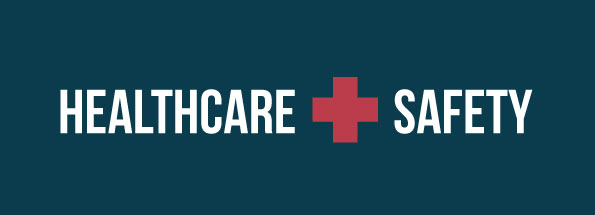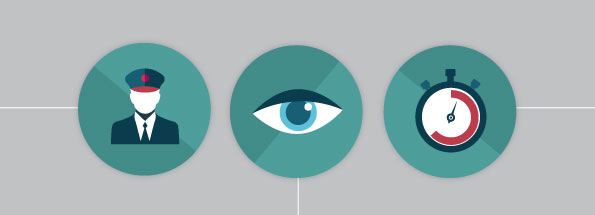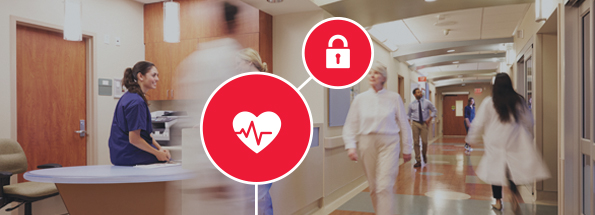5 Current Threats to Hospital Security

Treating patients is far from the only concern faced by hospitals today. To protect the safety of patients, visitors, and staff, hospitals must now take extra efforts to anticipate and prepare for security threats.
Hospitals are vulnerable to crime and violence from patients, visitors, and occasionally their own staff members. Therefore, security systems in hospitals must include proactive measures to create and reinforce effective security protocols geared towards accountability, readiness, and responsiveness.
The first step to designing an effective security system is understanding the threats themselves.
Here are some of the top security issues concerning hospitals today:
1. Abuse and battery towards medical staff
Assault and battery towards medical staff are the most common types of abuse-related injuries to occur within healthcare facilities. 80% of serious violent incidents reported in healthcare settings were caused by interactions with patients and were usually caused by patients hitting, kicking, beating, and/or shoving medical staff. There are many reasons that contribute to this. For one, patients may be victims of an incident caused by a dispute, creating a hostile or volatile environment inside the hospital. In other cases, patients may suffer from instabilities due to addiction or mental health issues.
At highest risk of patient-inflicted violence are psychiatric aides, who are more than ten times at higher risk than nursing assistants, the second-most affected group. Other high-risk groups include emergency departments, geriatrics, pediatrics, and behavioral health providers.
2. Active assailant attacks
Researchers at Brown University reported 241 hospital shootings between 2000 and 2015. Breaking this down, the majority of in-hospital shootings happened in the emergency room (29%), next to the parking lot (23%), and in patient rooms (19%).
As recent stories exemplify, simply having a plan is not enough. A recent active shooter situation at Dartmouth-Hitchock Medical Center exhibited the need for a much more comprehensive security approach. When the shooter entered the hospital and shot a patient, “Code Silver” was announced to all staff members. However, most staff did not know what the code meant, let alone how to react. The code has since changed to “Active Shooter,” along with other modifications to improve overall hospital security.
Bethesda Butler Hospital in Hamilton, Ohio is working to enhance training. They hired actors to practice emergency response to a hospital shooting. As Ronald J. Morris, the Director of Corporate Security for Tri-Health puts it, “It’s all about preparation and telling people about developing the right mindset so they can be more prepared.”
3. Infant abductions
Infant abduction is the most common type of abduction in healthcare facilities. According to the National Center for Missing and Exploited Children, 317 cases of infant abductions occurred between 1965 and 2017. The majority of cases of infant abduction occur in the mother’s hospital room, with violence inflicted on the mother in 8% of cases. Before more advanced security protocols came to form, many of the perpetrators disguised themselves as medical personnel to steal a child, usually from the hands of the mother.
In response, hospitals have cracked down on security measures and patient education practices that directly address this type of risk. The system does not need to be complex, but it should be effective. For example, access to maternity wards should be limited to qualified personnel or individuals who can prove their relationship to a patient. This can be further reinforced with badges that identify the security clearance of medical staff.
4. Supplies and property theft
From drugs, food, and medical supplies, you could make an A-Z list of items that are stolen from healthcare facilities. In 2009, hospitals reported 272 incidents of theft. By 2015, this number rose to 2,926 – a 166% increase. The result can be extremely costly. As a single example, the Santa Clara Valley Medical Center in San Jose, CA counted 383 stolen pieces of equipment between 2010 and 2014, totaling to over $11 million in value.
Culprits include patients, visitors, and also staff. An employee at the Christus Santa Rosa Hospital-Westover Hills in San Antonio, TX admitted to stealing over $400,000 worth of equipment because “it was easy and no one asked any questions.” Hospital theft is a good indication of a vulnerable security system, and also contributes to unnecessary overhead costs.
5. Pressure to cut costs
While 49% of hospitals reported an increase in crime between 2016 and 2017, nearly 1 in 4 hospitals (23%) reported a decrease in its hospital security budget over the same period. Part of this involves a reluctance to hire more security staff. In an anonymous survey, hospital workers mentioned “more [security threat] incidents, no increase in staff,” as a key challenge for hospitals.
Given its impact on security measures such as employee training, staffing, and security equipment, the pressure to cut costs is one of the most devastating restraints to an effective security solution. With $3.6 billion in federal budget cuts announced for 2018, hospitals need to prioritize security measures that combine effectiveness with cost-efficiency to strive for the best return on investment and highest possible level of security.
Security demands are changing, and hospitals must keep up to protect the security of their patients and staff. To address the increasing risk of in-hospital crime, hospitals must prioritize prediction and prevention of crime just as much as how they respond to and manage incidents. Solutions to achieve this include more advanced technology and data collection, increased security visibility to deter criminals, and bolstering in-house security presence and security response.
Now is the time to examine and refresh whether your hospital is in need of updated practices. Explore our healthcare security and risk mitigation solutions.



